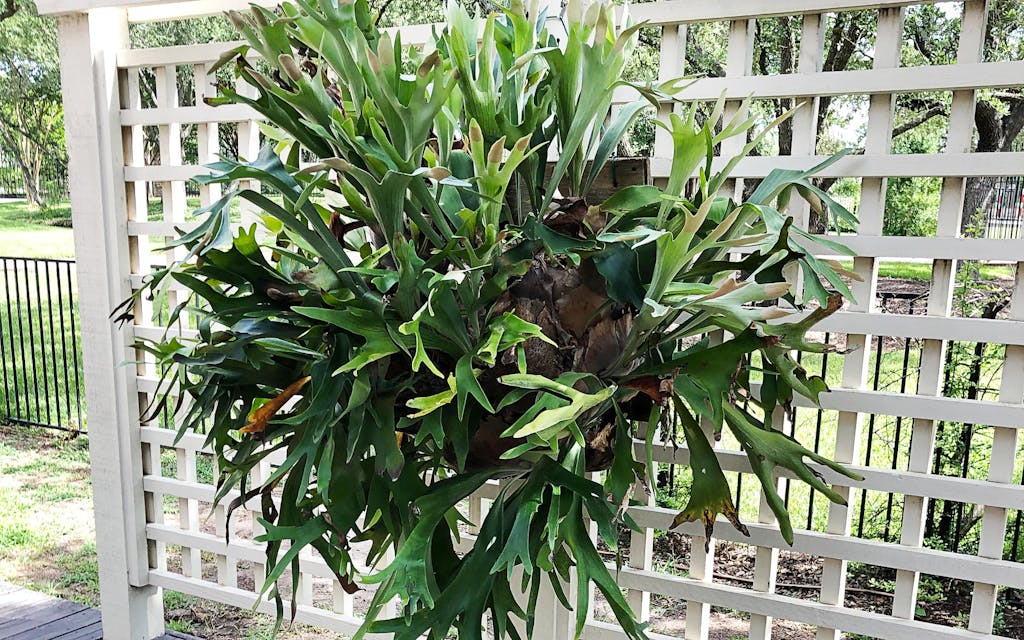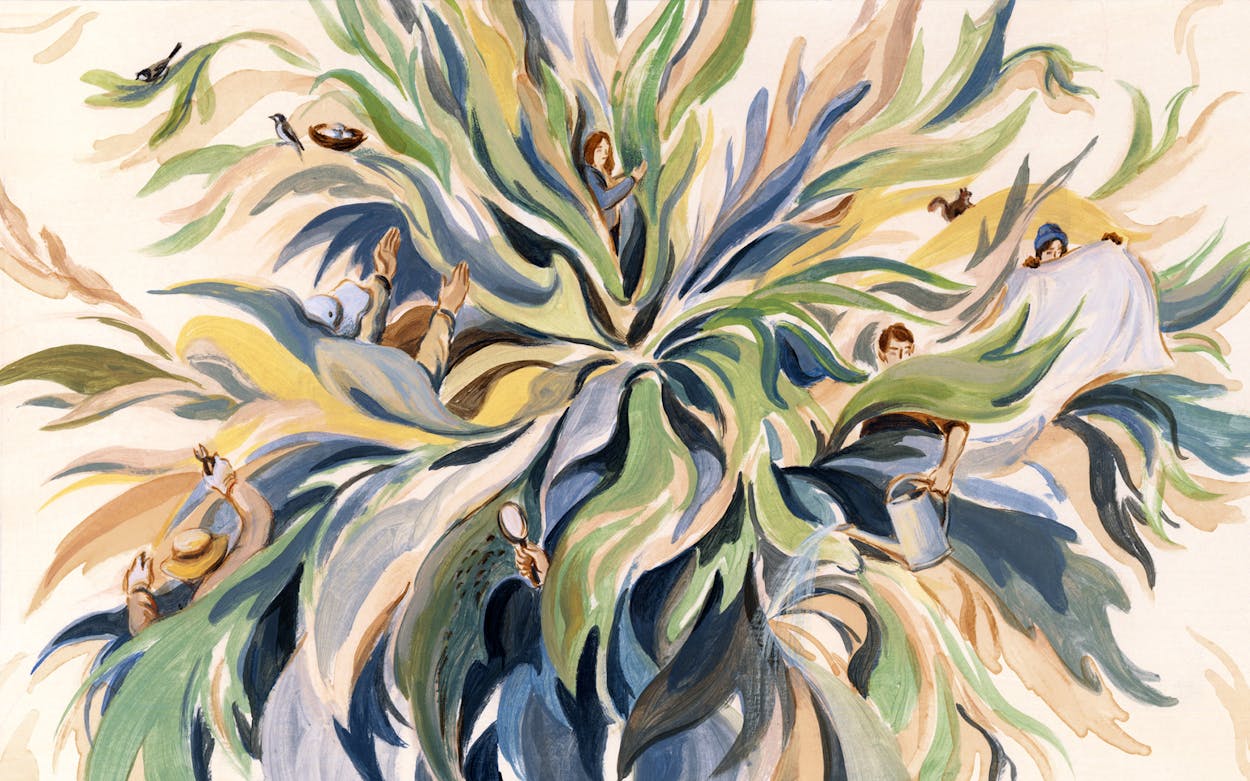I love hearing about what brings a family together. Maybe it’s the clam dip they serve every year during the Super Bowl, their top-secret, preposterously remote camping spot, or a weird but delicious salad dressing made from ketchup and onions. My own family has long been bonded by, among other things, an excellent piecrust recipe, a tedious ritual of counting the flatware after a meal to make sure no fork or teaspoon has ended up in the garbage, and a staghorn fern.
Our fern story starts in the mid-1970s, when Charlsie Urquhart, a longtime counselor at Clear Lake High School in Houston, gave my grandmother, Irene Cauley, a “pup” cut from her maturing staghorn fern. Charlsie’s son, Larry, was married to Irene’s daughter, my aunt Debbie, and the baby staghorn was a gift that I suspect Charlsie, a passionate gardener, was very proud of. For more than thirty years after that, the staghorn clung to a brick wall in the sheltered courtyard of my grandparents’ home near the Galleria. Over the decades, it grew into a magnificent and enormous showstopper.
Staghorn ferns are finicky about nearly everything. Named for its antler-shaped fronds, this genus of tropical plant is not native to anywhere remotely near Texas. For it to thrive, the weather must never get too cold. When it’s hot, as we all know it frequently is in Texas, staghorns require the perfect amount of dappled (but not too dappled) shade to survive the heat. And when it comes to water, I have found that staghorns behave much like Goldilocks. Too damp? Sometimes. Too dry? Frequently. And on rare occasions, just right.
My grandfather, Forest Cauley, was an architect. Everything about him—his hair, his handwriting, his toolbox—was precise, including his gardening style. Over many years, he constructed a series of elaborate structures out of PVC pipe and frost blankets to protect the staghorn, which eventually became too big for him to move by himself, from Houston’s occasional freezes. When he and my grandmother remodeled their home in the late eighties, they designed the courtyard’s landscaping specifically to shade and perfectly frame the plant, which had essentially become a member of the family. My sister and I, as well as our cousins, grew up knowing the fern’s strict watering schedule and learned early on how to assemble its bespoke freeze shelters to our grandfather’s strict specifications. I am the oldest of the cousins and also, it turns out, a plant nerd. While I was a college student at Rice, in the early nineties, I would dash to my grandparents’ house before every cold snap to help ready the staghorn. (And yes, to have a home-cooked meal.) I was not above stopping by while I was on a date to help water or cover. Looking back today, I can’t believe I actually did that, let alone that I expected there to be a next date. When Tropical Storm Allison was heading toward Houston in 2001, I was living in New York with the woman—Jannell, by then my wife—who’d agreed to keep dating me despite those pit stops. Watching coverage of the approaching storm on the news, I called my grandmother to check in. She let me know that she had hired movers to stow the staghorn, which by then probably weighed a hundred pounds, safely in the garage.
My grandfather died in 1999, followed by my grandmother in 2007. By the time she passed away, we were living back in Houston. Being a dutiful grandson and, by that point, one of those yard-obsessed dads who spend whole Saturdays with their edgers, I began going to her empty house to water or weather protect the staghorn. It had by then far outgrown the biggest of my grandfather’s contraptions. One day, months into this routine, I discovered the staghorn on the ground of the courtyard. It had fallen from the brick wall under its prodigious weight and was more than a little beaten-up. Dozens of its green antlers had broken, and of those that remained, only a few had been spared some sort of grotesque injury. So, as I would for any struggling family member, I opened my home to the plant. And that’s when I really got to know my family’s staghorn fern as a remarkable individual.
The staghorn, which has now developed a massive, natural bowl shape more than five feet across, is regularly host to litters of baby squirrels and, occasionally, broods of baby birds. Every winter, despite my devotion to its good health, it turns a dull gray-green and becomes spotted with fungus. This always worries me. Sometimes, in exchange for a glass or two of wine, I talk friends into helping me move it to a sunnier spot, where surely the fungus will clear up. But then, from spring through fall, it reliably unveils hundreds of huge, new, greener-than-green leaves. Most of these are classically antler-shaped, while others more closely resemble fluted soup bowls. (Some useless trivia, though not to a staghorn fern: the antler-shaped fronds are fertile, and the bowl-shaped ones are sterile. And they each have very specific functions.) Yes, my fern is finicky, but it’s also inordinately resilient. One of the most heartbreaking moments in my plant-lover existence occurred when a freak few inches of snow fell in Houston. I raced home from a business trip to Kansas City to cover the staghorn, moving up my flight in an attempt to beat the sudden shift in the weather. I didn’t get home in time, and my heart sank over the next few days as the staghorn lost all of its fronds. But within six months, a hundred more had grown back.

I’m now in my early fifties, and the staghorn is only a few years younger. The fern has moved with me from Houston to Austin (to follow my dream to work at Texas Monthly) and from house to house in both cities. In each new setting, it takes me and the staghorn a few months to find a spot that meets most of its needs, but we always figure it out. I faithfully cover it with blankets when it gets cold. In August and September, I water it before the sun comes up, and again after it goes down, so as not to risk magnifying the light (and because, just like a wise drinker, it doesn’t like too much at once). Every time someone new visits my house, I tell them Charlsie and Irene’s story, and then I lead them outside. Visitors are universally impressed. (Or perhaps they ooh and ahh for my benefit.) Before the big February freeze of 2021, I, too, hired movers to put the staghorn in the garage.
And then, four months ago, it fell while I was at work. A wire framework I never knew my grandfather had built for it to grow around had finally snapped under the weight of all the excess water the plant had retained after a heavy rainfall. (When I got home from work that day, Jannell met me at the door and said, “I have very bad news.” My first thought was that someone had been in a car wreck.) For my Christmas 2021 present, my seventeen-year-old son, August, who will be entering the architecture school at Auburn University next year, built and installed a new wooden backboard and a cagelike wire framework that I anticipate the plant will grow around and make disappear within a couple of years. He doesn’t share my preoccupation with plants, but he knows this one is important, and he covers it for me every time I ask. August made certain the new framework is strong enough to give us a decade or more before we have to think about it again. I couldn’t have been more pleased with the gift.
On January 25, a crew of five big guys hoisted the staghorn back onto the deeply set bolts that it hangs from on a latticed wall behind my house in Austin. That night I texted a picture of the plant—returned to its rightful spot, but fairly battered by its recent fall, by the cage August had constructed around it, and by another winter—to my aunt and uncle, my cousins, my mom, and my sister. In the ensuing text thread, we recounted the staghorn’s story, and we agreed Charlsie and Irene would be pleased (but also that I am obsessive). Finally, we determined that one of us needs to raise a future plant person, since the staghorn will surely outlive me.
In fact, I might already have done just that. Last weekend I mentioned this essay to my fourteen-year-old daughter, Loulou. To my surprise (but not really, for she is a lot like me in certain ways), she said, “I think I want the staghorn when I grow up.”






